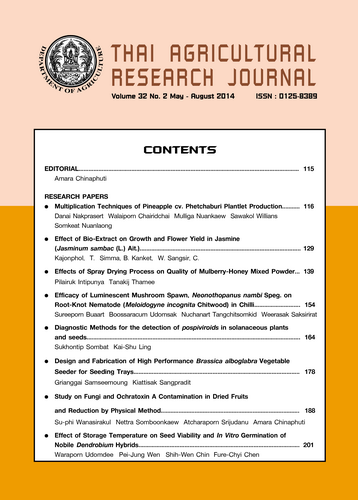Study on Fungi and Ochratoxin A Contamination in Dried Fruits and Reduction by Physical Method
DOI:
https://doi.org/10.14456/thaidoa-agres.2014.17Keywords:
dried fruit, ochratoxin A, mycotoxin decontamination, heatingAbstract
The aim of this study was to determine and reduce the contaminations of fungi and ochratoxin A (OTA) in imported and local dried fruits sold in market of Thailand. Three hundred and six samples were collected from 20 different types of dried fruits. Aspergillus niger, A. flavus, A. aculeatus, Rhizopus sp., Penicillium sp. and Fusarium sp. Were detected in 159 samples (from 14 fruit varieties). OTA contamination was analyzed by an enzyme-linked immunosorbent assay (ELISA) technique. OTA were detected in 19 varieties of dried fruit (234 samples) between 0.10 and 24.10 μμg/kg. The highest OTA content was found in dried blueberry with 24.10 μμg/kg followed by white raisin (13.00 μg/kg) and dried cranberry (9.55μ μg/kg). Thus, these three dried fruit varieties were selected to decontaminate OTA using heat from hot air- or microwave ovens. Interactions of heating times and power significantly influenced the reduction of OTA contamination. The OTA levels in dried blueberry decreased by 28.46% after treated with microwave oven at 400 watt for 45 second. Higher OTA reductions were detected in white raisin (84.56%) and dried cranberry (74.35%) after microwave-heat at 400 watt for 60 second and 800 watt for 45 second, respectively. OTA contents in dried blueberry, white raisin and dried cranberry, heated at 80 °C hot air oven for 60 minutes, were dropped by 43.30, 81.85 and 83.59%, respectively. The results indicate that heating by either hot air- or microwave ovens could be an alternative method to reduce the OTA contamination in various dried fruits.
Downloads
Published
How to Cite
Issue
Section
License
Copyright (c) 2017 วารสารวิชาการเกษตร (Thai Agricultural Research Journal)

This work is licensed under a Creative Commons Attribution-NonCommercial-NoDerivatives 4.0 International License.
Thai Agricultural Research Journal



